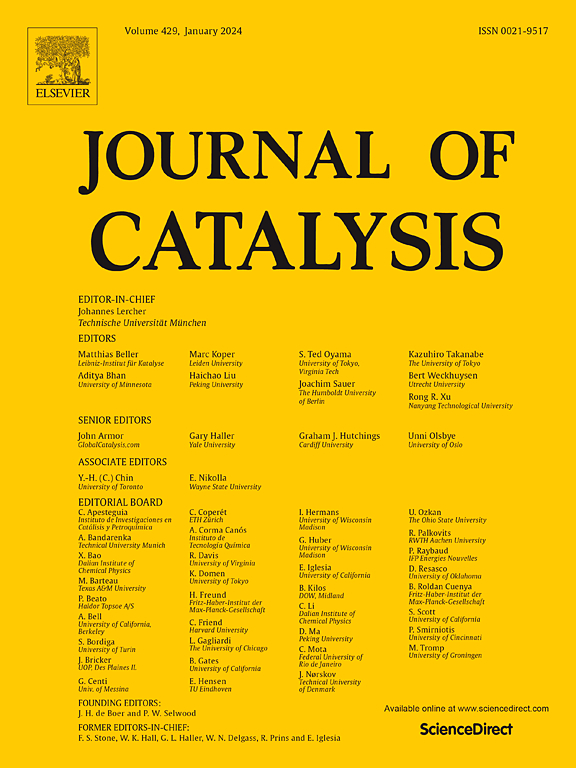Passivation of Brønsted acid sites at external surfaces of MFI zeolites and effects on propene oligomerization catalysis
IF 6.5
1区 化学
Q2 CHEMISTRY, PHYSICAL
引用次数: 0
Abstract
Alkene oligomerization to higher molecular weight products is a useful route for converting light hydrocarbon gases to liquid transportation fuels. Heterogeneous distributions of Brønsted acid sites in zeolites, arising from spatial gradients of Al centers in intracrystalline regions and at unconfined extracrystalline surfaces, influence rates, selectivity, and deactivation for acid-catalyzed reactions. Here, we synthesized core@shell materials composed of Al-MFI cores and Si-MFI shells of varying thickness, characterized crystallite-scale Al distributions by elemental analysis and electron microscopy, and quantified fractions of external acid sites by mesitylene benzylation rate constants. Propene oligomerization rates (503 K), interpreted using effectiveness factor formalisms, revealed the strong influence of intracrystalline diffusion limitations caused by the occlusion of heavier oligomer products within zeolitic micropores during reaction, consistent with prior reports. Transient changes in dimerization rates upon step changes in propene pressure revealed more severe diffusion limitations for Al-MFI@Si-MFI than Al-MFI materials possessing external acid sites, despite similar transient 2,3-dimethylbutane adsorption rates (298 K) on both core and core@shell materials indicating that additional diffusion resistances were not introduced inherently into core@shell materials via siliceous shell growth. Rather, passivation of external acid sites allows in situ formation of recalcitrant surface carbonaceous deposits during oligomerization catalysis, which caused irreversible deactivation with time-on-stream requiring regeneration under oxidative treatments. Overall, these findings provide kinetic and mechanistic insights into the role of external acid sites in zeolites to mitigate the formation of recalcitrant carbonaceous deposits during reaction, which introduce additional diffusional barriers that influence rates, product selectivity and deactivation of zeolites during alkene oligomerization.


求助全文
约1分钟内获得全文
求助全文
来源期刊

Journal of Catalysis
工程技术-工程:化工
CiteScore
12.30
自引率
5.50%
发文量
447
审稿时长
31 days
期刊介绍:
The Journal of Catalysis publishes scholarly articles on both heterogeneous and homogeneous catalysis, covering a wide range of chemical transformations. These include various types of catalysis, such as those mediated by photons, plasmons, and electrons. The focus of the studies is to understand the relationship between catalytic function and the underlying chemical properties of surfaces and metal complexes.
The articles in the journal offer innovative concepts and explore the synthesis and kinetics of inorganic solids and homogeneous complexes. Furthermore, they discuss spectroscopic techniques for characterizing catalysts, investigate the interaction of probes and reacting species with catalysts, and employ theoretical methods.
The research presented in the journal should have direct relevance to the field of catalytic processes, addressing either fundamental aspects or applications of catalysis.
 求助内容:
求助内容: 应助结果提醒方式:
应助结果提醒方式:


